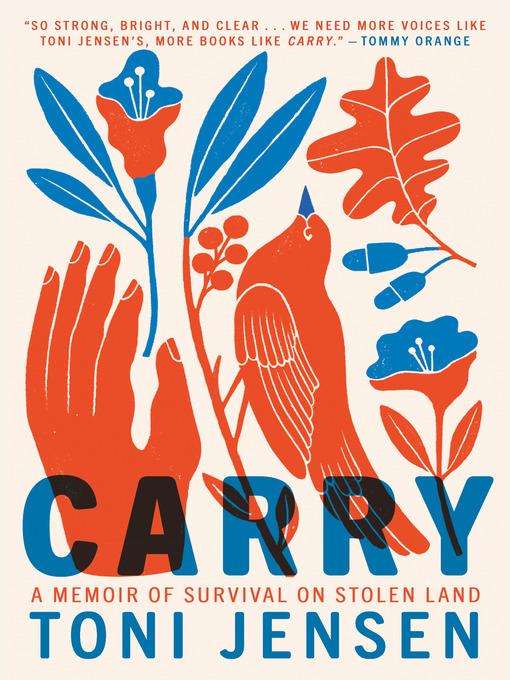
Carry
A Memoir of Survival on Stolen Land
کتاب های مرتبط
- اطلاعات
- نقد و بررسی
- دیدگاه کاربران
نقد و بررسی

August 1, 2020
Moving between personal recollections and historical observations, Jensen (Univ. of Arkansas; Inst. of American Indian Arts) narrates what it means to be M�tis, and what it feels like to be connected by bodies and land. Beginning by describing life in a fracking town, Jensen considers the history of land, from her hometown in Audubon County, IA, to the Standing Rock Reservation to each campus she attends, either as a student or as a professor. For Jensen, this is also a story about the cost of passing for white without trying. The degradation and exploitation of Indigenous women is never far from mind. How do we do memorialize the dead while being present for the living? She passionately shows how people become who they are, including her dad, who had a history of alcohol abuse and violence. These are the strongest parts of the book, as is her exploration of her ancestors, Road Allowance People from the southern prairies of Canada. The inclusion of sociological definitions, while sometimes distracting, underscores Jensen's aim to remind us that the language we use to discuss these issues is inextricably linked to cultural history. VERDICT A meditative exploration of people and place that shows what it means to live and survive.--Stephanie Sendaula, Library Journal
Copyright 2020 Library Journal, LLC Used with permission.

August 1, 2020
Debut memoir from a Native author enmeshed in the American way of violence, alienation, and death. Jensen, who teaches writing at the University of Arkansas and the Institute of American Indian Arts, is M�tis, a descendant of mixed European and Native American ancestors. Of a childhood friend who professed to being part-Native, she writes memorably, "Of course, I objected to the language, the 'part.' Which part? The back of the left knee? The curve of the right ankle? The crook of an elbow? How many ways do we carve ourselves up and portion out our parts, our bodies for other people's comfort?" The string of onrushing questions is typical of Jensen's rhetorical stance, which is urgent and occasionally scattershot. When she lands on a target, she does so effectively: Her on-the-ground reports from the Bakken shale country, near the Standing Rock Reservation and its pan-Native protests against resource extraction, are illuminating, and her visceral reaction to the thought that students on her campus are now allowed to carry concealed weapons--even after so many school shootings--makes for a powerful rejection of a culture that has always been grounded in violence and intimidation. Jensen also looks back on an encounter with a mentally ill and potentially murderous student in Kingman, Arizona, where she taught for a time while looking at Oklahoma City bomber Timothy McVeigh's old haunts. That terrorist act, she observes, caused the most number of civilian casualties in this country until 9/11. She pointedly adds, "you don't have to leave the state of Oklahoma to find other examples, though," such as the massacre of African Americans in Tulsa in 1921 and "the 8,700-17,000 Choctaw, Creek, Chickasaw, Cherokee, and Seminole people who died during the Removal Era." Mostly on point and sure to interest those opposed to a world of angry men and their guns, bulldozers, and writs.
COPYRIGHT(2020) Kirkus Reviews, ALL RIGHTS RESERVED.

October 12, 2020
In this stirring series of essays, Jensen, a Métis writer and English professor at the University of Arkansas, muses on an expansive range of pressing issues facing America today. The unifying theme is violence: domestic violence; violence against Indigenous people; violence linked to mental health and poverty; and the violence of erasure via white supremacy. In the title essay, Jensen writes that in 2018 “according to a new law, anyone who’s licensed can come to Kimpel Hall carrying a handgun, to my office, Kimpel 221, carrying a handgun, to my classroom, carrying a handgun.” She then reveals, in a chilling turn, that she sits down the hall from where, in 2000, “a graduate student, recently expelled from the program,” shot a professor. In another notable essay, “Dog Days,” Jensen tells of her abusive father and how after many years they “have made a sort of peace with each other.” Jensen also provides an inside look into Standing Rock and the Dakota Access Pipeline protests in the powerful “Women in the Fracklands.” This beautiful assemblage of essays braids a visceral reminder of America’s current troubles, and a deeper understanding of how they came to be.

























دیدگاه کاربران